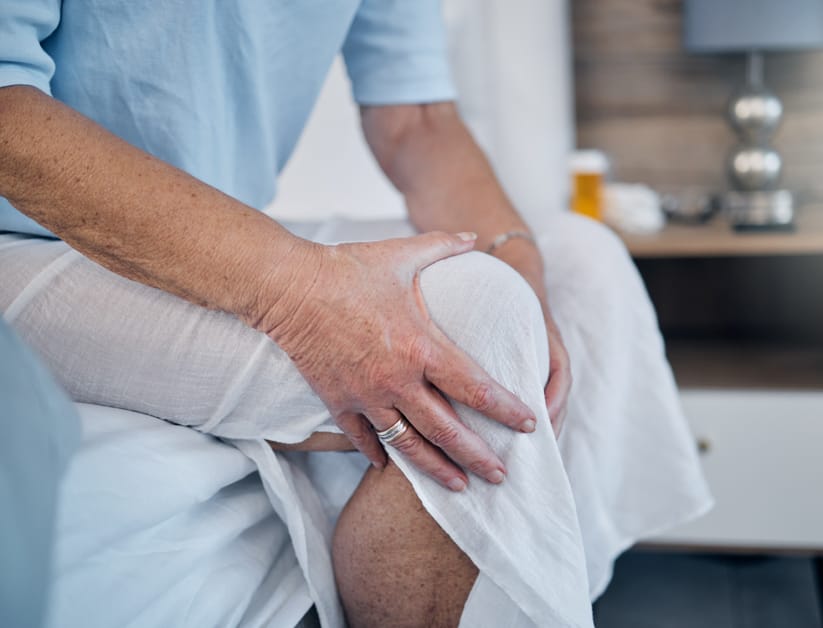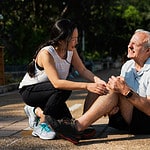Introduction
Aging can be tricky. It causes joint pain and stiffness due to the wear and tear of cartilage and muscles. Knees are especially vulnerable as they are used for walking, running, jumping, and squatting. All these activities become slower with age.
So, it’s important to know how aging affects knee pain. Muscles weaken as we age. This reduces stability in the knee joint. Osteoarthritis (OA) is a progressive condition caused by degeneration of cartilage. This damages ligaments, tendons, and even bones. Aging also reduces circulation in the knees, making recovery from injury more difficult.
To manage aged related knee pain, ask your doctor about lifestyle modifications, physical therapy, and approaches like acupuncture or massage therapy. These can provide natural relief without resorting to potentially harmful treatments like opioids or surgery.
Causes of Knee Pain in the Elderly
Knee pain is a common issue, particularly for elderly people. Many possible causes exist: age-related wear and tear, injury, infection, or medical conditions. Let’s discuss the most usual causes of knee pain in seniors and how to manage it naturally.
Age-related degeneration
As people age, the risk of developing degenerative conditions increases – particularly in the knee joint. One such condition is osteoarthritis, which is caused by the wearing down of cartilage. Symptoms include swelling, pain and a decreased range of motion.
Bursitis is another common condition among seniors, which occurs due to excess friction in the joint. Symptoms include stiffness, tenderness and difficulty straightening the joint.
Meniscal tears may also be a cause of knee pain in elderly individuals. These tears occur in the meniscus – two semi-circular discs located at either end of a bushing. This may lead to popping sounds, difficulty bearing weight and decreased strength.
MRI imaging is used to diagnose meniscal tears.
Osteoarthritis
Knee pain is a frequent complaint in those aged 60 and over. Osteoarthritis is the main cause of this. Cartilage in the knee joint wears down gradually from regular use or impact. Symptoms include stiffness, swelling, and pain which may worsen on humid days. People with osteoarthritis may find it hard to climb stairs or bend their knee enough to put on socks or shoes.
To manage osteoarthritis, it is wise to be aware of what helps and worsens your symptoms. A tailored exercise program such as walking, swimming, or riding a stationary bicycle may help reduce pain. Stretching exercises with correct alignment can stop injuries and lessen discomfort. Products such as warm supports around the knee joint can provide extra comfort without making symptoms worse. Applying ice packs after more strenuous activities can also reduce pain and inflammation. Talk to your doctor for advice concerning treatments such as supplements or medical procedures like injections or surgery if needed.
Injury
Injuries can be a frequent cause of knee pain in the elderly. With age, balance and muscle strength reduce, upping the risk of falls. Such injuries can be mild; yet, worse ones may cause ligament instability or fractures, in which case medical help should be sought quickly.
Also, osteoarthritis (OA), rheumatoid arthritis (RA), tendinitis and bursitis might lead to knee pain.
Overuse
Knee injuries in older adults are often caused by overuse. The cartilage that cushions the joint wears out, and when too much weight is placed on it, pain can occur. This type of injury ranges from mild to severe, depending on the amount of padding and the activity performed.
Arthritis, post-traumatic arthritis, and muscle imbalances can also cause knee pain in the elderly due to overuse. Poor alignment and incorrect posture while walking or standing for long periods can also be a factor.
It is important to speak with a doctor if any injury is suspected. Early diagnosis and treatment are key for preventing long-term damage or disability, such as Osteoarthritis or Rheumatoid Arthritis. Exercises tailored to joint degeneration can help strengthen muscles around the joint, reducing stress, increasing mobility, and preventing further damage. Physical Therapy and anti-inflammatory meds may bring relief from the pain.
Symptoms of Knee Pain
Knee pain – an ailment that affects people of all ages – can be especially tough for older adults. It can vary from a mild nuisance to painful and disabling.
Signs of knee pain? Swelling and inflammation, tightness, tenderness, walking struggles, and a popping feeling.
In this article, we’ll explore the symptoms, origins, and treatments for knee pain.
Swelling
Knee swelling is a key symptom of knee pain. Edema is the fluid retention that causes it. This leakage increases pressure in the area, leading to pain. Swelling is a normal reaction, but it can block movement and be uncomfortable.
Signs of swelling include:
- Tenderness
- Stiffness
- Redness
- Heat
- Tight skin feeling
- Leaking
- Red streaks
Natural treatments can reduce swelling. These include:
- Compression
- Rest
- Elevating your feet
- Icing
- Massage
- Stretching
- Strengthening
- Supplements, such as fish oils, glucosamine, and chondroitin sulfate.
Stiffness
Knee pain and stiffness is an age-related problem. It starts as twinges, but can worsen. Range of motion decreases, making it hard to do tasks like climbing stairs or squatting. You may also find that when taking stairs or walking fast, there is stiffness.
Other signs include:
- Pain that gets worse when you run or walk quickly
- Swelling around the knee after activity
- Trouble bending and straightening the knee
- Pain when putting weight on the leg
- Itching or burning around joints
- Stiffness when waking up
- Knee giving away
If you have any of these symptoms, go to your doctor for diagnosis and treatment.
Pain
Pain is a common symptom for adults aged 65 and over with knee pain. It may feel like a dull ache or sudden, sharp stabbing sensations when the knee is moved. Pain can occur in one area of the knee, or spread to others.
Other symptoms of knee pain include:
- Tenderness
- Clicking/grinding noises
- Stiffness
- Weakness
- Swelling
- Instability
- Limited mobility
- Limping
Weakness
Knee pain can produce weakness in the area. This might be from inflammation, disuse or muscle atrophy. Weakness may result in difficulty getting up from a seat, climbing stairs or even walking on flat surfaces.
To tackle the knee weakness, do strengthening workouts that focus on muscles around the joint and slowly gain strength. Ask a doctor or physical therapist for exercises and stretches to fit your individual needs. Try changing activities like running or sports too, with less intensity or less range of motion to reduce discomfort.
Treating Knee Pain Naturally
Knee pain? Common problem. Especially for older folk. Looking for natural solutions? You’re here! This will cover different approaches to reducing knee pain… naturally!
Rest
Resting your body is vital for healing. When you have knee pain, it’s key to get lots of sleep and rest. This will ease the strain on your joints. It will also help reduce swelling and allow healing elements, like anti-inflammatories and lubricants, to develop in your joints.
It’s wise to prevent activities that require knee motion or weight on your knees, as this can worsen the discomfort. If desired, prop up the injured leg with pillows when lying or sitting. Gentle stretching may be helpful for knee pain. But speak to your doctor first, to ensure which stretches are safe.
Hot and cold therapy is a great way to treat knee pain naturally. Applying heat can alleviate pain. And alternating with cold packs can reduce swelling.
Exercise
Exercise is useful for decreasing knee pain. It’s also a great way to manage age-related knee pain. Exercise keeps the muscles around your knees strong and flexible, reducing force on your joints. It can also help you maintain a healthy weight, which takes the pressure off your knees.
When starting an exercise program to manage knee pain, it’s important to begin slowly. The American College of Rheumatology suggests that physical activity should be started “progressively and patient-centered” to get the best results, while avoiding injury. Your doctor or physical therapist can help you design an individual program and modify it as needed.
Low impact exercises such as swimming and biking, and range of motion exercises to keep the joint area flexible, are often prescribed. Also, strengthening exercises (with weights at home or in physical therapy) can help build muscles that safeguard and protect the knee joint from more injury or hurt. Strengthening around the hips is also important, because strong hips can reduce strain on other leg areas, including the knees.
Stretching
Stretching is essential for lessening knee joint ache, increasing flexibility, and strengthening the muscles that hold up the knee. Regularly stretching the nearby muscles and supportive tissues can help restore balance and reduce strain on the joint when you move.
Low-impact activities like swimming, yoga, tai chi, and Pilates are wonderful for stretching as they can help build strength within the muscle groups that support your knee gently. Non-weight bearing activities such as cycling and using an exercise bike can be beneficial too.
Dynamic stretching (stretching while in motion) can also provide great comfort from pain as it warms up your muscles and increases blood circulation, promoting healing of soft tissue. Gentle ballistic stretches (small jumps) may be effective, but should always be done cautiously, as too much momentum can do more harm than good! A seasoned physical therapist or coach can assist you in learning the right exercises and stretches for your individual needs.
Heat and Cold Therapy
Heat and cold therapy are both great for knee pain. Heat helps reduce inflammation and gets blood flowing to the area. It can also reduce stiffness and improve range of motion. Use an electric heating pad with a removable cover or wraps with clay-based formulas. Each session should last 15-20 minutes with breaks in between.
Cold therapy is used to reduce inflammation and pain due to strain or sprain. It numbs the area and reduces swelling. Ice packs or bags of frozen vegetables can be used, as long as they are wrapped in a cloth. Limit treatment to no more than 20 minutes, and wait at least an hour before reapplying.
Massage
Massage therapy has been known to treat knee pain related to aging. It increases flexibility and range of motion. Also, massage helps reduce pain, and boosts circulation in the area. This brings more oxygen to the joints, which helps soothe the aching knees.
For those with inflammation due to injury or arthritis, massage therapy may provide relief. This can be done through gentle kneading of the injured area. Together with heat and cold compresses, as well as other treatments like aromatherapy or reflexology, massage can be a natural way to reduce knee pain.
Herbal Remedies
Herbal remedies are centuries old and used to treat a variety of ailments, like knee pain. They can be used on their own or together with other treatments, and are a low-risk and cost-effective option compared to prescription medications. Chamomile, valerian root, ginger, turmeric, yarrow, licorice root, and arnica are a few of the many herbs available. These herbs help with inflammation and manage pain.
When selecting herbal remedies, it’s best to consult a healthcare provider to find out which ones are best for you.
- Chamomile is an old herb that helps reduce muscle soreness.
- Valerian root helps relax muscles and reduce inflammation.
- Ginger has powerful antioxidant properties to reduce inflammation in cells, and soothe joints and muscles.
- Turmeric is a well-used herb for a variety of illnesses due to its anti-inflammatory properties.
- Yarrow decreases swelling from arthritis or other conditions.
- Licorice root is good for joint stiffness and soreness, plus it has natural pain relief qualities.
- Arnica is used for muscle spasms, swelling, and bruising around injured joints.
Prevention
Before examining natural remedies to reduce knee pain, it is important to understand the causes. To prevent them, there are several things one can do! Here, we will focus on the most efficient preventative measures:
Maintain a Healthy Weight
Maintaining a healthy weight is essential to prevent diseases like diabetes, high blood pressure and heart disease. To stay in the healthy range, there are a few steps to take.
First, find out your body mass index (BMI). Ask your doctor or health care provider to help calculate it. BMI is determined by height and weight and helps you understand your health risks related to body fat.
Also, limit the calories you consume daily and be active. Eat enough nutrient-rich food like lean proteins and complex carbohydrates with fiber. Avoid processed and junk foods; they are low in nutrition and usually contain added sugar and fat which should be limited. Lastly, do 150 minutes of physical activity each week. Examples include brisk walking, running, playing sports or taking an exercise class.
Making the right food choices and having an active lifestyle will guarantee you stay within the healthy weight range!
Eat a Balanced Diet
A balanced diet can really make a difference when it comes to healthy knees. Focus on consuming a variety of produce, lean proteins, and healthy fats like nuts, seeds, avocados and fatty fish. Vitamin D is important too. Get it from fatty fish, eggs and mushrooms.
Calcium-rich foods are beneficial for strong bones, like yogurt, kale, broccoli, fortified milk and canned salmon.
Modify your eating habits. Cut back on added sugar and refined carbs, and avoid processed foods to reduce inflammation. Use olive oil instead of palm oil. Incorporate healing herbs and spices like ginger, turmeric and garlic. They contain compounds that fight inflammation caused by aging. Lastly, try to avoid drinks with caffeine. Research shows that consuming more than one caffeinated beverage daily can increase the risk of osteoarthritis.
Exercise Regularly
Exercising is a must for keeping knee pain at bay as you age. Low-impact activities such as swimming, biking, walking, yoga, Tai chi and Pilates are best. Listen to your body: rest when you need it.
Strength training exercises like squats, lunges and step-ups can help with joint stability. Stretching is key for maintaining flexibility, especially if it has become stiff due to pain. Targeted stretching exercises can improve mobility so you can carry on with daily activities more comfortably.
Wear Appropriate Shoes
Wear shoes that fit correctly and provide arch support. Shoes with thicker soles provide better cushioning for knees. Add extra cushioning with an air-filled insole. Avoid high heels and flip-flops.
Stretch before physical activities. Tight muscles can cause damage. These steps help reduce knee pain due to aging.
Avoid Overuse
It is essential to maintain physical activity, but know your body’s limits. Start with low intensity and increase over time. This allows muscles and joints to get used to the activity. Also, cross-train to keep muscles flexible and balanced. Regular stretching helps with posture, circulation, and range of motion.
Be aware of symptoms of overuse such as sharp pain, swelling, and pain that lasts longer than 8 weeks. Also, stiffness after inactivity, local tenderness, radiating pain, weakness such as instability when walking or climbing stairs. Stop exercising and seek medical advice if any of these occur.
Conclusion
Knee pain is common among aging adults. Osteoarthritis is a common type of arthritis in senior citizens. If you’re an aging adult, there are steps you can take to reduce knee pain.
- Stretching each day can make the muscles around your knees stronger and more flexible.
- A healthy diet with less processed food can lower inflammation in the body, including your knees.
- Taking joint health nutrition and doing activities like yoga can help reduce knee pain.
- Consult with a doctor or physical therapist to find out what works best for you to manage natural degeneration in aging knees.
Frequently Asked Questions
Q1: What are the most common causes of knee pain as you age?
A1: The most common cause of knee pain as you age is osteoarthritis, which is caused by a breakdown of cartilage in the knee joint. Other causes of knee pain can include tendonitis, bursitis, or an injury.
Q2: What natural treatments can I use to cope with knee pain?
A2: Natural treatments for knee pain include exercising regularly, applying ice or heat to the affected area, taking over-the-counter medications such as ibuprofen and acetaminophen, and using natural supplements such as glucosamine and chondroitin.
Q3: Are there any lifestyle changes I can make to help reduce knee pain?
A3: Yes, making lifestyle changes such as maintaining a healthy weight, stretching regularly, and avoiding activities that can put strain on your knees can help reduce knee pain.





